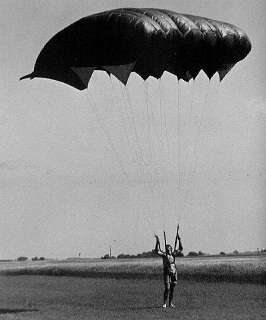Bede Wing
The Bede Wing was an inflated hang glider, designed in the 1970s by aeronautical engineer Jim Bede. Intended as a safer alternative to conventional hang gliders,[2] it resembled an early ram-air parachute, but instead was an inflatable structure, that could be filled with air for gliding, or with helium to act as a gas balloon.[3]
| Bede Wing | |
|---|---|
 | |
| Role | Inflatable hang glider |
| Manufacturer | Bede Aircraft |
| Designer | Jim Bede |
| Unit cost |
$890[1] |
The aspect ratio of the Bede Wing was low, in the area of 1.8. Fitted with unusually long suspension lines, the Bede Wing had almost no dihedral.[4] It was also reported to have a lower sink rate than conventional hang gliders of the time.[5]
Although Bede intended to start full production of the Bede Wing,[5] the project came to nothing. However, it foreshadowed the introduction of ram-air inflated paragliders in the mid-1980s.
References
- "Bede Wing Purchase Offer-Sales Contract" (PDF). (54.6 KB) retrieved 2010-10-13
- Pelham, David (2000). Kites. Overlook Press. p. 86. ISBN 978-1-58567-017-8.
- "What's New", Popular Science, New York: Times Mirror Magazines, 207 (3), p. 78, September 1975
- Patent number 3,944,169, the Bede Wing
- Air Facts: the magazine of safe flying, volume 37. Air Facts, Inc., 1974.